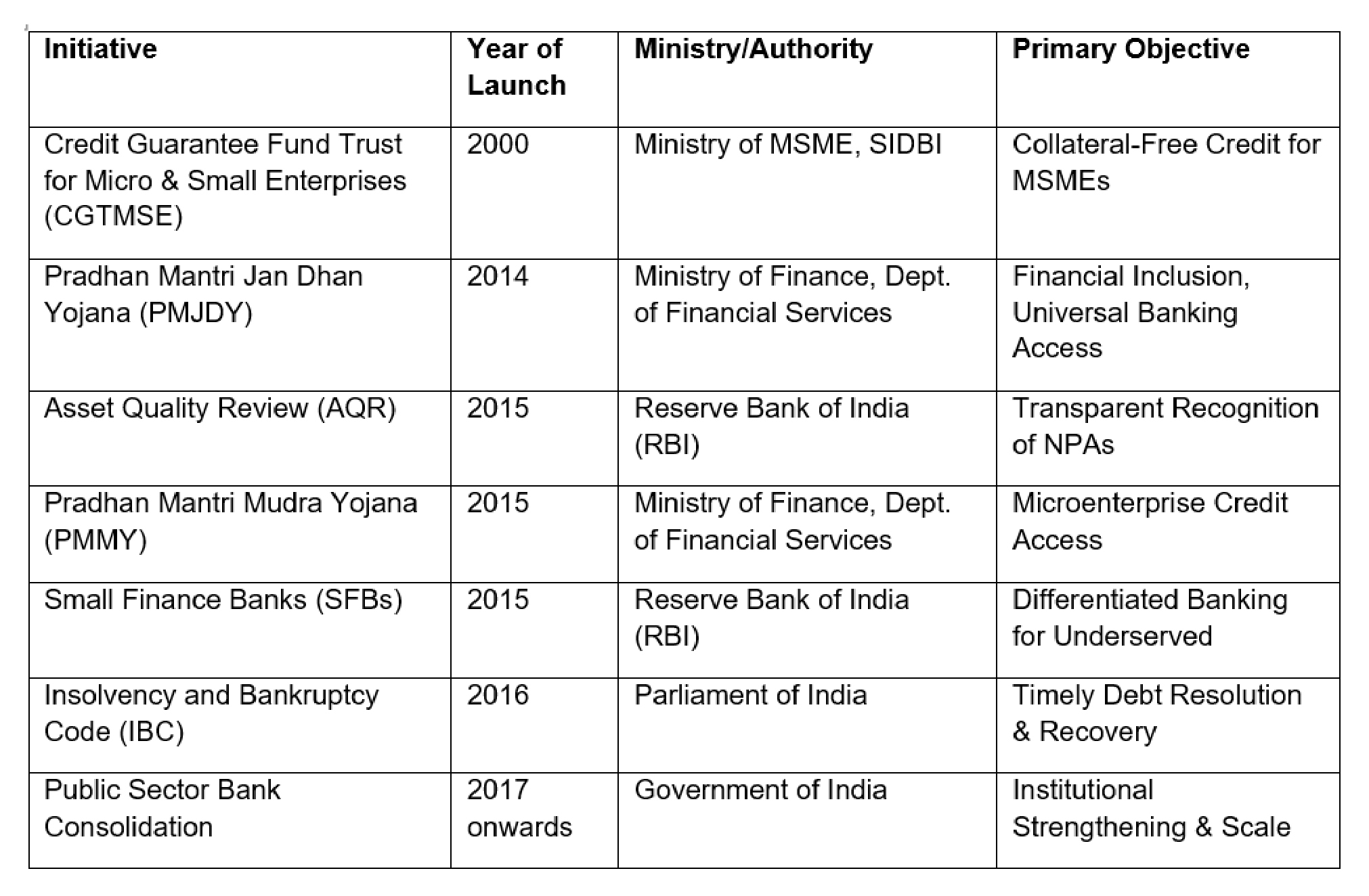SEARCH
RECENT POSTS
Categories
- Agriculture (30)
- Automobiles (18)
- Banking and Financial services (33)
- Consumer Markets (48)
- Defence (6)
- Ecommerce (21)
- Economy (67)
- Education (13)
- Engineering (6)
- Exports (21)
- Healthcare (24)
- India Inc. (8)
- Infrastructure (29)
- Manufacturing (27)
- Media and Entertainment (15)
- Micro, Small & Medium Enterprises (MSMEs) (15)
- Miscellaneous (30)
- Perspectives from India (33)
- Pharmaceuticals (4)
- Railways (4)
- Real Estate (16)
- Renewable Energy (17)
- Research and Development (9)
- Retail (1)
- Services (6)
- Startups (15)
- Technology (53)
- Textiles (6)
- Tourism (13)
- Trade (5)
How Government Initiatives are transforming the Indian Banking Sector

- Nov 20, 2025, 12:30
- Banking and Financial services
- IBEF
The Indian banking sector has undergone significant transformation over the past few decades, tackling challenges such as non-performing assets and capital shortages, while embracing technology to drive financial inclusion. These shifts have strengthened the sector, making it more inclusive and sustainable, and positioning it as a key pillar of India’s economic ambitions. As the country aspires to become a global economic power and a developed nation by 2047, with milestones of a US$ 5 trillion economy by 2027-28 and US$ 10 trillion by 2034, banks will play a critical role. They must fund infrastructure, support small and medium enterprises, and adopt green business practices to enable sustainable growth. Achieving a developed status, often linked to a per-capita income of US$ 12,000–15,000, remains a long-term goal, with India’s per-capita GDP at US$ 2,731 in 2023 and projected to reach about US$ 14,000 by 2041-42, alongside a US$ 22 trillion economy.
A new policy paradigm for India’s banking sector
Before recent reforms, India's banking sector faced major problems. A large part of the population was not in the formal financial system. At the same time, banks struggled with rising NPAs. In 2012, the gross NPA ratio hit a six-year high of 3.1%. Most of this stress came from corporate lending, particularly in the industrial sector. From 2009 to 2019, lending growth was also slow, averaging only 4% a year. Past efforts to boost financial inclusion had limited success. The Swabhimaan programme was a national effort in 2011. It sought to provide banking access to unbanked individuals. However, the programme's reach was limited, and it lacked technology. The government and the Reserve Bank of India jointly launched a new policy. This initiative, the National Strategy for Financial Inclusion (NSFI) 2019-2024, addresses the challenge directly. This plan focused on both institutional health and financial inclusion. It used a wide-ranging, technology-driven approach. This new dual strategy uses technology and government schemes to reach the unserved.
The digital leap: Building an inclusive financial future for India
India's banking system has undergone a major change. This change focused on bringing financial services to people with limited access. It was a planned economic strategy, not just a social programme. The goal was to formalise the economy. This would boost both consumption and credit flows.
- Digital foundation: The J-A-M trinity
The Aadhaar biometric ID system, launched in 2010, was a key step in India's digital shift. It gave people a unique, verifiable identity. This made the Know Your Customer (KYC) process faster and cheaper. As a result, it supported broader financial inclusion efforts. The full effect came from the Jan Dhan, Aadhaar, and Mobile (JAM) Trinity, which linked Jan Dhan bank accounts, Aadhaar and mobile phone numbers. This created a secure digital system. It allowed for the efficient delivery of financial services and government benefits. This integrated approach solved issues present in earlier inclusion campaigns. For instance, previous efforts were limited and didn't fully use technology to reach all households.
- The Pradhan Mantri Jan Dhan Yojana (PMJDY): A national mission
Launched in August 2014, the PMJDY is a national effort. The goal is to offer banking services to all unbanked homes. The programme provides a zero-balance savings account. It also includes a free RuPay debit card and an overdraft option. The PMJDY has greatly benefited society and the economy. It has brought millions into the formal financial system. This has reduced dependence on informal money lenders. It also serves as a direct channel for government payments, which helps limit corruption. By February 2025, 54.97 crore accounts were opened. However, account dormancy is a key problem. As of July 2025, 13.04 crore accounts, or 23%, were inactive. This issue is due to low financial literacy and poor connectivity. The programme now focuses on promoting the active use of these accounts. This will help ensure full financial inclusion for all.
- Advancing digital payments: The UPI revolution
India's 2016 demonetisation policy first boosted digital payments. However, the Unified Payments Interface (UPI) has driven the main growth. Since its launch, UPI's transaction volume has grown fast. In August 2025, it reached 20 billion. This success comes from its open design, ease of use and zero cost for users. This digital shift has brought clear economic gains. The International Monetary Fund (IMF) found that more mobile money can help rural areas recover from shocks. It also boosted sales for informal businesses by around 26%. Yet, the UPI model has a major challenge. Users pay no transaction fees. Banks and private firms that maintain the system earn little to no money.
Key government initiatives and their primary objectives

Broadening access to credit for MSMEs and underserved sectors
Government programmes aim to close the credit gap for Micro, Small, and Medium Enterprises (MSMEs). This supports entrepreneurship and creates new jobs. Such initiatives also stimulate economic growth. They help achieve universal financial inclusion.

The way forward
Over the past decade, Indian government initiatives have transformed the banking sector. The JAM Trinity and UPI have built a strong digital framework, boosting financial inclusion. The government's focus on expanding credit access for MSMEs has also spurred entrepreneurship and job growth. The future of Indian banking will depend on solving current problems faced by Indian banking sector. It will require long-term use of digital services, not just creating new accounts. This will mean balancing public policy with the commercial health of the banking system. The use of AI and cooperation with FinTech firms will be key. This will help improve efficiency, manage risk and promote faster credit growth. The success of these efforts will be judged by their impact on India’s economic growth. It will also be measured by their contribution to a more equal society.
FAQs
How have government initiatives transformed the Indian banking sector?
They shifted banks from struggling with NPAs and low financial inclusion to becoming technology-driven, inclusive and digitally integrated.
What role does the JAM Trinity play in financial inclusion?
It links Jan Dhan accounts, Aadhaar and mobile numbers to provide secure, low-cost financial access and efficient DBT (Direct Benefit Transfers).
What challenges does PMJDY face despite its success?
Dormant accounts remain a concern, with about 23% inactive due to low financial literacy and digital connectivity issues.
How are government schemes supporting MSMEs?
They provide easier credit access, reducing dependency on informal lending, supporting entrepreneurship and creating jobs.
What will shape the future of India’s banking sector?
Sustained digital adoption, AI integration, fintech collaboration, green banking practices and balanced profitability will be key drivers.
















